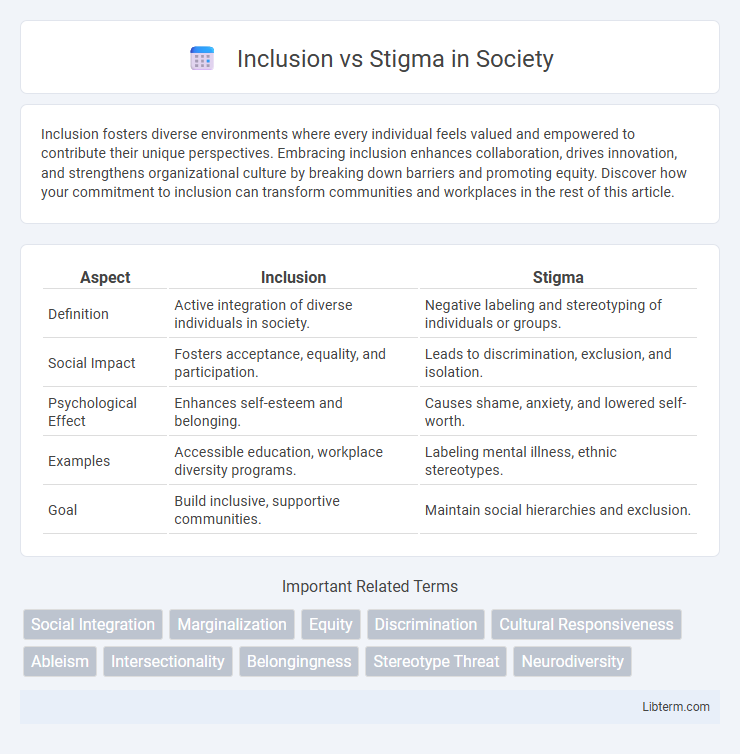Inclusion fosters diverse environments where every individual feels valued and empowered to contribute their unique perspectives. Embracing inclusion enhances collaboration, drives innovation, and strengthens organizational culture by breaking down barriers and promoting equity. Discover how your commitment to inclusion can transform communities and workplaces in the rest of this article.
Table of Comparison
| Aspect | Inclusion | Stigma |
|---|---|---|
| Definition | Active integration of diverse individuals in society. | Negative labeling and stereotyping of individuals or groups. |
| Social Impact | Fosters acceptance, equality, and participation. | Leads to discrimination, exclusion, and isolation. |
| Psychological Effect | Enhances self-esteem and belonging. | Causes shame, anxiety, and lowered self-worth. |
| Examples | Accessible education, workplace diversity programs. | Labeling mental illness, ethnic stereotypes. |
| Goal | Build inclusive, supportive communities. | Maintain social hierarchies and exclusion. |
Understanding Inclusion: Definitions and Importance
Inclusion emphasizes creating environments where individuals of all abilities, backgrounds, and identities feel valued, respected, and empowered to participate fully. It involves removing barriers and fostering equitable access to opportunities, promoting social cohesion and personal development. Understanding inclusion's importance highlights its role in reducing stigma, enhancing mental health, and driving organizational success.
The Roots and Impact of Stigma
Stigma originates from deep-rooted social stereotypes and cultural misconceptions that label individuals or groups as inferior or deviant. This negative labeling leads to exclusion, discrimination, and psychological harm, impeding social cohesion and access to essential resources. Understanding the roots of stigma is crucial for fostering genuine inclusion, which promotes acceptance, equity, and the dismantling of harmful biases within communities.
Barriers to Inclusive Communities
Barriers to inclusive communities often stem from deep-rooted stigma and social exclusion, which perpetuate misunderstandings and reinforce negative stereotypes about marginalized groups. Structural obstacles such as inaccessible infrastructure, discriminatory policies, and lack of representation further hinder equitable participation. Overcoming these barriers requires intentional efforts to promote empathy, education, and inclusive practices that dismantle prejudices and foster a sense of belonging for all individuals.
Social Stigma: How It Manifests
Social stigma manifests through negative stereotypes, discrimination, and exclusion of individuals based on attributes like mental health, disability, or ethnicity. It results in diminished social opportunities, barriers to healthcare access, and internalized shame that affect overall well-being. Persistent stigma reinforces inequality, making inclusive practices essential to promote acceptance and equal participation in society.
Benefits of Embracing Inclusion
Embracing inclusion fosters diverse perspectives, enhancing creativity and problem-solving in workplaces and communities. Inclusive environments promote mental well-being and reduce discrimination, leading to higher employee engagement and productivity. Organizations that prioritize inclusion often experience stronger social cohesion, improved innovation, and better overall performance.
Psychological Effects of Stigma
Stigma generates negative psychological effects such as increased anxiety, depression, and diminished self-worth, undermining an individual's mental health and social functioning. Internalized stigma often leads to self-isolation and reluctance to seek support, exacerbating feelings of loneliness and stress. Promoting inclusion fosters acceptance and belonging, which are critical for psychological resilience and improved well-being.
Strategies for Promoting Inclusion
Promoting inclusion involves implementing strategies such as awareness campaigns, diversity training, and policy development that address and dismantle stigma in various social and professional settings. Creating safe spaces for open dialogue encourages empathy and understanding among individuals from diverse backgrounds. Organizations benefit from inclusive hiring practices and ongoing education that foster a culture of acceptance and reduce discriminatory behaviors.
Addressing and Reducing Stigma
Addressing and reducing stigma involves promoting inclusive practices that foster understanding and acceptance of diverse identities and experiences. Implementing education programs that challenge stereotypes and encourage empathy helps dismantle harmful misconceptions. Creating supportive environments where open dialogue is encouraged increases awareness and reduces the negative impacts of stigma on mental health and social participation.
Role of Policy in Fostering Inclusion
Effective policy frameworks play a critical role in fostering inclusion by mandating equal access to education, employment, and healthcare for marginalized groups. Anti-discrimination laws and affirmative action policies reduce stigma by promoting diversity and ensuring representation in social, economic, and political spheres. Inclusive policies also facilitate awareness campaigns and community programs that challenge stereotypes and support social integration.
Building a Culture of Acceptance
Building a culture of acceptance requires prioritizing inclusion practices that recognize and value diverse identities and experiences, thereby reducing stigma in social and professional environments. Implementing education programs and open dialogues fosters empathy and understanding, which dismantle prejudices and promote equity. Organizations and communities that embed inclusive policies actively challenge stereotypes, creating safe spaces where individuals feel respected and empowered.
Inclusion Infographic

 libterm.com
libterm.com